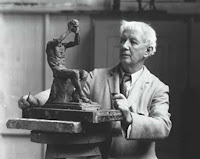 |
| The Swann Fountain, 1924, Philadelphia, Alexander Stirling Calder |
 |
| Alexander Stirling Calder. No, the work is not titled "Cure for a Really Bad Headache." |
Mobiles, stabiles, bent wire sculptures...who comes to mind? Alexander Calder, of course. The problem bedeviling those studying art, and American sculpture in particular, is that there were no less than three Alexander Calders. Art runs in families. First there was Alexander Milne Calder who is best known for creating the bronze full-length figure of William Penn atop the Philadelphia city hall dome in 1875. He was born in 1845 in Scotland, the son of a tombstone carver. His son, was Alexander Stirling Calder (right), famous for his Swann Fountain (top) in Philadelphia. And finally, he was the father of the most famous of the three, Alexander "Sandy" Calder, born in 1898, the guy who made all the mobiles. (See the posting for 11-18-10 for more on him.)
Now, just to keep things straight, Alexander Stirling Calder (the middle one) was born in 1870. He died in 1945. If it helps any, this Calder is often referred to as A. Stirling Calder. I won't get involved in name and dates for the Scottish progenitor of the clan, things are complicated enough as it is. Suffice to say stone cutting runs deep in this family's tree, even though "Sandy" Calder worked mostly in welded metals. One might refer to them as the Peale family of sculpture, after Philadelphia's most famous art family.
Young Stirling Calder started his art training (apart from that which he undoubtedly received at home) at the Pennsylvania Academy of Fine Arts under the tutelage of none other than the great American painter, Thomas Eakins. He was sixteen at the time. In 1890, the young man moved on to Paris to study at the Academy Julien and from there to the granddaddy of them all, the École des Beaux-arts. In other words, he had the best art education money could buy.
Back in Philadelphia, Stirling Calder's first major effort came in winning the competition for a sculpture of Dr. Samuel Gross, the same Samuel Gross depicted in Thomas Eakins' famous painting, The Gross Clinic (above). In fact, Calder largely copied the pose from his former teacher's work. Next came a series of twelve larger-than life statues of Presbyterian ministers for Philadelphia's Witherspoon Building. This was during a time when every major new architectural edifice just had to be adorned with at least life-sized effigies of famous men or classical figures devoid of decent apparel. During his career, Stirling Calder often taught classes at his alma mater as well as at the National Academy Design and the Art Students League in New York.
 |
| Dr. Samuel Gross, 1897, A. Stirling Calder |
Back in Philadelphia, Stirling Calder's first major effort came in winning the competition for a sculpture of Dr. Samuel Gross, the same Samuel Gross depicted in Thomas Eakins' famous painting, The Gross Clinic (above). In fact, Calder largely copied the pose from his former teacher's work. Next came a series of twelve larger-than life statues of Presbyterian ministers for Philadelphia's Witherspoon Building. This was during a time when every major new architectural edifice just had to be adorned with at least life-sized effigies of famous men or classical figures devoid of decent apparel. During his career, Stirling Calder often taught classes at his alma mater as well as at the National Academy Design and the Art Students League in New York.
During the early 1900s, Calder came down with tuberculosis, causing him to move to Arizona for his health, which caused him to be in the right place at the right time to serve as co-chief of sculpture (along with Karl Bitter) for the 1915 San Francisco World's Fair. When Bitter died suddenly that same year, Calder was chosen to complete work on Bitter's Depew Fountain (Fountain of Energy) in Indianapolis, which featured a robust ring of scantily clad teenaged bronze figures dancing around a central fount, enjoying a refreshing drenching on a hot summer day. Several other public monuments in New York and Philadelphia followed, including his most famous work, the Swann Memorial Fountain (top) in his hometown and the monumental statue of Lief Eriksson (1929) standing before the Lutheran Cathedral in Reykjavik, Iceland, about as far away from his hometown as he ever got.




No comments:
Post a Comment